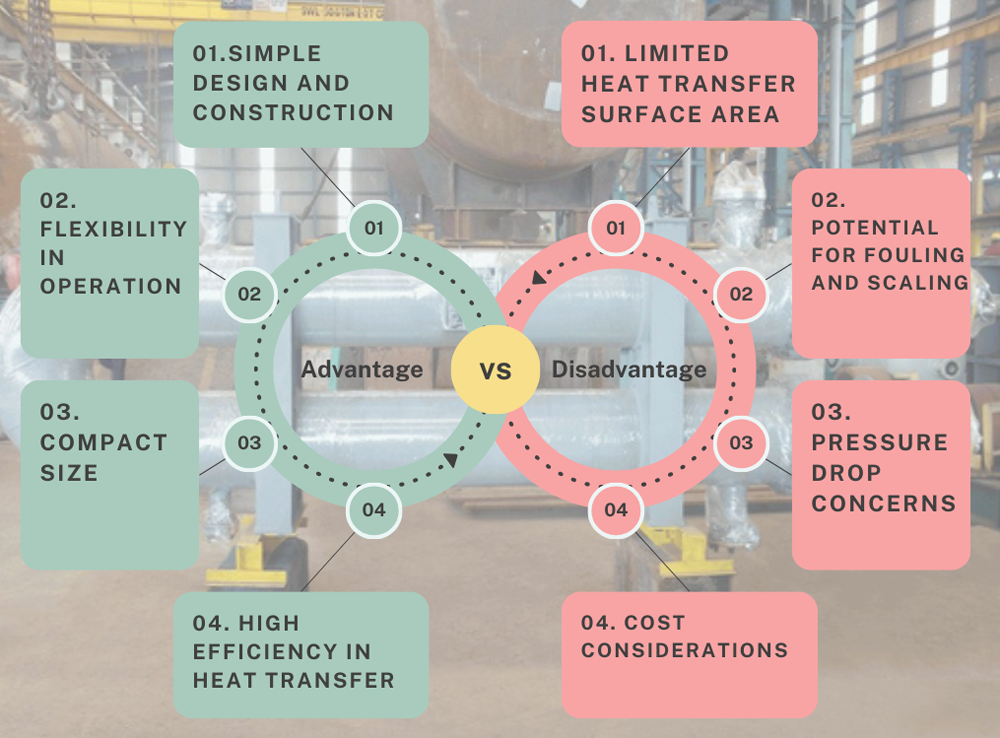
Double pipe heat exchangers are a fundamental type of heat exchanger commonly used in various industrial processes. They consist of two concentric pipes, one inside the other, where two fluids flow—one through the inner pipe and the other through the annular space between the two pipes. The primary purpose of a double pipe heat exchanger is to transfer heat between these two fluids efficiently.
The importance of double pipe heat exchangers lies in their simplicity, cost-effectiveness, and versatility. They are widely used in applications where smaller heat transfer areas are sufficient, such as in chemical processing, food and beverage production, and HVAC systems. This article aims to provide a detailed analysis of the advantages and disadvantages of double pipe heat exchangers, helping users make informed decisions based on their specific needs and constraints.
1.Inner and Outer Pipes: The double pipe heat exchanger consists of two concentric pipes: an inner pipe and an outer pipe. The inner pipe carries one of the fluids, while the outer pipe carries the other fluid. This arrangement allows for efficient heat transfer between the two fluids, as they flow in close proximity but are separated by the walls of the inner pipe.
2.Flow Arrangement (Counterflow and Parallel Flow):
Counterflow Arrangement: In this configuration, the two fluids flow in opposite directions. This arrangement maximizes the temperature gradient between the fluids over the length of the heat exchanger, resulting in higher heat transfer efficiency.
Parallel Flow Arrangement: In this configuration, the two fluids flow in the same direction. While this arrangement is simpler to design and construct, it is generally less efficient than the counterflow arrangement due to a lower temperature gradient.
1.Heat Transfer Mechanism: The working principle of a double pipe heat exchanger is based on the transfer of heat from the hotter fluid to the cooler fluid through the walls of the inner pipe. The efficiency of this heat transfer depends on the temperature difference between the fluids, the thermal conductivity of the pipe material, and the surface area available for heat exchange.
2.Flow Dynamics:
Laminar and Turbulent Flow: The flow of fluids within the heat exchanger can be either laminar or turbulent, depending on the Reynolds number. Turbulent flow enhances heat transfer due to increased mixing and higher convective heat transfer coefficients.
Pressure Drop: As fluids flow through the heat exchanger, they experience a pressure drop due to frictional resistance. The design of the heat exchanger aims to minimize this pressure drop while maintaining efficient heat transfer.
The straightforward design of double pipe heat exchangers makes them relatively easy to manufacture, involving the assembly of two concentric pipes. This simplicity reduces production time and costs, making them an economical choice for many applications. Additionally, they are particularly cost-effective for small-scale applications due to their minimal material requirements.
Double pipe heat exchangers offer operational flexibility, accommodating both counterflow and parallel flow arrangements. This adaptability allows users to select the most efficient flow configuration for their specific heat transfer needs. Furthermore, the accessible design facilitates easy maintenance and cleaning, ensuring long-term efficient operation.
The compact design of double pipe heat exchangers makes them ideal for applications where space is limited. Their small footprint allows for easy installation in confined spaces, such as laboratories or small industrial plants. Their lightweight and portable nature also make them suitable for temporary installations or applications requiring frequent relocation.
The counterflow arrangement in double pipe heat exchangers maximizes the temperature gradient between the hot and cold fluids, leading to more efficient heat transfer. This configuration allows for greater heat exchange over the length of the exchanger compared to parallel flow arrangements. Additionally, the design minimizes heat losses, ensuring that most of the heat is effectively transferred between the fluids.
Double pipe heat exchangers have a relatively limited heat transfer surface area compared to other types of heat exchangers, such as shell and tube or plate heat exchangers. This limitation makes them less suitable for large-scale heat exchange applications or situations requiring high heat transfer rates. Their efficiency diminishes when handling large volumes of fluids.
Fouling and scaling can be significant issues in double pipe heat exchangers, particularly when dealing with fluids that have a high potential for depositing solids or scaling on the pipe walls. These deposits reduce the efficiency of heat transfer and increase the need for frequent maintenance and cleaning, which can be labor-intensive and costly over time.
Double pipe heat exchangers can experience higher pressure drops compared to other heat exchanger designs. The pressure drop occurs due to frictional resistance as the fluids flow through the narrow spaces of the concentric pipes. This pressure loss can impact the overall performance of the system, especially in applications requiring high flow rates or those sensitive to pressure variations.
While double pipe heat exchangers are cost-effective for small-scale applications, they can become expensive when scaled up. The costs associated with larger units, including materials and construction expenses, can be higher compared to more efficient designs like shell and tube or plate heat exchangers. This makes them less attractive for large-scale industrial applications where cost efficiency is a critical factor.
Shell and tube heat exchangers consist of a series of tubes, one set carrying the hot fluid and the other the cold fluid, enclosed within a cylindrical shell. They offer a much larger heat transfer surface area compared to double pipe heat exchangers, making them suitable for large-scale industrial applications. Their design allows for handling high-pressure fluids and offers better resistance to fouling due to the larger surface area.
Plate heat exchangers are made up of multiple thin, corrugated plates stacked together, with hot and cold fluids flowing through alternating plates. This design provides a very high heat transfer surface area in a compact space. They are highly efficient and suitable for applications requiring precise temperature control. However, they are more prone to fouling and require more frequent maintenance compared to shell and tube heat exchangers.
| Feature/Characteristic | Double Pipe Heat Exchanger | Shell and Tube Heat Exchanger | Plate Heat Exchanger |
| Design | Two concentric pipes | Series of tubes within a cylindrical shell | Multiple thin, corrugated plates stacked |
| Heat Transfer Surface Area | Limited | Large | Very high |
| Efficiency | Moderate | High | Very high |
| Suitability for Large Scale | Less suitable | Highly suitable | Suitable, depending on the application |
| Maintenance | Easy | Moderate | Requires frequent maintenance |
| Fouling Resistance | Moderate | High | Moderate to low |
| Pressure Drop | High | Moderate | Low to moderate |
| Cost for Large Units | High | Moderate | High |
This comparison highlights the strengths and weaknesses of each type of heat exchanger. Double pipe heat exchangers are simple and cost-effective for small-scale applications but fall short in larger-scale operations due to limited heat transfer surface area and higher pressure drops. Shell and tube heat exchangers, while more complex and costly, offer better efficiency and are suitable for larger applications. Plate heat exchangers provide the highest efficiency and compact design but require careful maintenance and can be more expensive.
Double pipe heat exchangers are a fundamental type of heat exchanger known for their simplicity, flexibility, and cost-effectiveness in small-scale applications. Their straightforward design allows for easy manufacturing, maintenance, and operation, making them a popular choice in various industries, from chemical processing to HVAC systems.
Despite their advantages, double pipe heat exchangers have limitations, including a restricted heat transfer surface area, potential fouling and scaling issues, and significant pressure drops. These factors make them less suitable for large-scale or high-volume heat exchange applications.
In comparison, shell and tube heat exchangers offer a larger heat transfer surface area and better suitability for high-pressure and large-scale operations, while plate heat exchangers provide exceptional efficiency and compact design but require frequent maintenance.
Ultimately, the choice of heat exchanger depends on the specific requirements of the application. Double pipe heat exchangers are ideal for smaller, simpler applications where cost and ease of maintenance are priorities. For more demanding applications, shell and tube or plate heat exchangers may be more appropriate, despite their higher initial costs and complexity. Understanding the advantages and limitations of each type is crucial for selecting the most effective and efficient heat exchanger for any given process.
Feel free to leave your message on our board. If you're looking to inquire about prices or place an order, this is the right place! Let us know the details of your needs, and our team will get back to you with a personalized quote as quickly as possible. We're here to ensure your experience is seamless and satisfactory. Share your requirements or ask any questions you might have - we're eager to assist and look forward to doing business with you!
Name:Tim
Phone:+86-15716151880
Email:[email protected]
Company:BEANT
Address:No. 28, Luoshen Road, Luoshe Town, Huishan District, Wuxi City, Jiangsu Province
